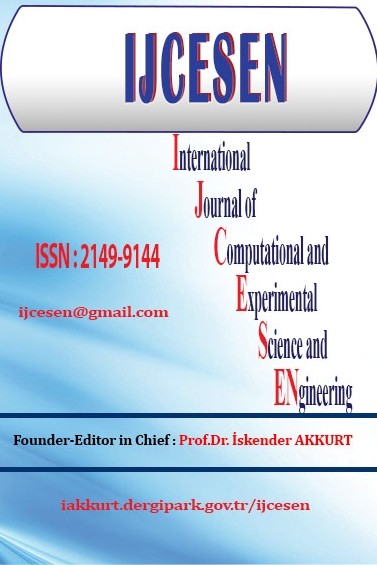Determination of The Cross Types to be used in a Trailer Chassis by Finite Element Method
Determination of The Cross Types to be used in a Trailer Chassis by Finite Element Method
Trailer, Cross Member, Finite Element Method FEA, Transportation,
___
- Uluslararası Nakliyeciler Derneği, Statistics (30.10.2018), https://www.und.org.tr/tr/19744/Istatistikler
- Akhtar, M. J. (2017), Master Thesis, Aalto University, Development of Guidelines for the Selection of Structural Profiles to Achieve Optimized Flooring Structure.
- Shinde, D., Kalita, K., “FE Analysis of Knuckle Joint Pin Used in Tractor Trailer.” ARPN Journal of Engineering and Applied Sciences 10 (2015) 2227-2232.
- Sane, S.S., Jadhav, G., Anandaraj, H., “Stress Analysis of Light Commercial Vehicle Chassis by FEM”, Piaggio Vehicle Pvt. Ltd, Pune, India (1955).
- FEA for All, Linear Static Analysis (18.10.2018), http://feaforall.com/linear-static-analysis-fea/
- Esener, E., Ercan, S., Fırat, M., “Determination of the Fatigue Behavior of a Wheel RimUsing Finite Element Analysis”, 4th Int. Conf. on Comp. and Exp. Scien. and Eng. (ICCESEN-2017) , Antalya-Turkey pp. 617-619 (2017) DOI: 10.12693/APhysPolA.132.617
- Altair OptiStruct Linear Analysis 13.0 Manual
- Karaçalı, Ö., “Computational Material Analysis of Structural and Hemodynamic Model of Coronary Stent by CFD/FEA in Computer Aided Mechanical Engineering Approach”, 3rd Int. Conf. on Comp. and Exp. Scien. and Eng. (ICCESEN-2016) Antalya-Turkey pp. 249-251(2016). DOI: 10.12693/APhysPolA.130.249
- Karaçalı, Ö., “Computational Engineering Analysis of Low-Cycle Loading for AMF-Active Micro Forceps 316 L-Stainless Steel Material by Finite Element Method”, 2nd Int. Conf. on Comp. and Exp. Scien. and Eng. (ICCESEN-2015) Antalya-Turkey pp.B-40-42 (2015). DOI:10.12693/APhysPolA.128.B-40
- Altair HyperWorks 14.0 Manual
- Altair University, Material and Property Information (28.10.2018), http://altairuniversity.com/wp-content/uploads/2014/02/matprop1.pdf
- TS 2162 EN 10025, Table 5, Turkish Standards Institution, 1996
- Özer, H., Can, Y., Yazıcı, M., “Investigation of the Crash Boxes Light Weighting with Syntactic Foams by the Finite Element Analysis”, 4th Int. Conf. on Comp. and Exp. Scien. and Eng. (ICCESEN-2017) , Antalya-Turkey pp. 734-737 (2017). DOI: 10.12693/APhysPolA.132.734
- Özsoy M., Pehlivan K., Fırat M., Özsoy N., Uçar V., “Structural Strength and Fatigue Life Calculation of Y32 Bogie Frame by Finite Element Method”, 2nd Int. Conf. on Comp. and Exp. Scien. and Eng. (ICCESEN-2015) Antalya-Turkey pp.B-327-329 (2015). B-327-329. DOI: 10.12693/APhysPolA.128.B-327
- Yayın Aralığı: 4
- Başlangıç: 2015
- Yayıncı: Prof.Dr. İskender Akkurt
Tolga PALANDIZ, Ramazan ŞENOL, Hilmi Cenk BAYRAKÇI
Utilization of Marble and Boron Waste in Brick Products
Atilla EVCİN, Bahri ERSOY, Hakan ÇİFTÇİ
Wei ZHAO, Huiqing LIU, Chuan LU, Jing WANG, Lin MENG, Ruihong ZHONG
Effect of Change in Radial Clearance on Pressure Variation of Fluid in Hydrodynamic Journal Bearing
Experimental Comparison of Al5083 Alloy Subjected to Annealing and Equal-Channel Angular Pressing
Mehmet ŞAHBAZ, Hasan KAYA, Aykut KENTLİ, Mehmet UÇAR, Serkan ÖĞÜT, Kerim ÖZBEYAZ
The Key Factor Analysis to the Reservoirs on the Basis of Bayesian Law
Jian SUN, Qi LI, Mingqiang CHEN, Zekai ZHANG
Clustering of European Countries in terms of Healthcare Indicators
Natural Radiation Measurement in Some Soil Samples from Basra oil field, IRAQ State
Hadi ALBIDHANI, Kadir GUNOGLU, İskender AKKURT
Determination of The Cross Types to be used in a Trailer Chassis by Finite Element Method
